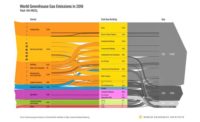
The governments of California and Québec have become the first in North America to link their greenhouse-gas cap-and-trade systems, enabling companies to swap GHG emission allowances or credits in a joint carbon market. The agreement, which took effect on Jan. 1, follows new regulations in both jurisdictions requiring companies to purchase credits for each tonne of carbon dioxide they send into the atmosphere.
Robin Fraser, a Toronto-based analyst with the International Emissions Trading Association, said the agreement will strengthen the carbon market in both Québec and California by expanding the trading market for participating companies, leading to cheaper emissions reductions. Fraser added that, if successful, the system could provide incentives to other states and provinces. “Other jurisdictions who may be waiting to see how it goes down may decide to create a program of their own and link with California and Québec as well.”
Cap-and-trade was a central plank of the Western Climate Initiative, struck by seven western U.S. states and four Canadian provinces in 2007. Since then, most of those jurisdictions have backed away from implementation of cap-and-trade and, in the case of British Columbia, opted to lower emissions through a revenue-neutral carbon tax.
Québec trade minister Jean-François Lisée said the joint cap-and-trade agreement with California will encourage companies “to strive for excellence and go the extra mile in researching and developing new technologies to reduce greenhouse-gas emissions.” Québec hopes to reduce, by 2020, its greenhouse-gas emissions by 25% below 1990 levels.
In addition to the environment itself, other beneficiaries could be environmental engineers. Quebec’s Martin Tampier, hired by industry for his advice on carbon markets, believes a joint carbon market will be good for both California and Québec. The process, he adds, won’t change in either jurisdiction. If one tonne of CO2 equals a single credit and a powerplant emitting nine million tonnes of CO2 per MWH is suddenly faced with a cap of 5 million, the company will need to reduce that.
“I need to buy four million credits to cover those four million of excess CO2 emissions. That could be $10 or $15 per tonne, but that’s what I have to pay for them,” Tampier says.
So far, Québec companies have been lukewarm to cap-and-trade. During the province’s first allowance auction in December, only a third of 2013 allowances and a quarter of 2016 allowances were sold, at the basement price of CA$10.75 ($9.71). The government believes demand for offsets and credits will gain steam in January 2015, when fuel distributors fall under the carbon regulation.
The Canadian Fuels Association (CFA), representing downstream facilities such as oil refineries and retail gas outlets, hopes the government will reconsider and exempt its members from cap-and-trade. CFA Vice President Carol Montreuil says there is still insufficient liquidity—that is, too few jurisdictions participating in a joint cap-and-trade system—to make it work effectively. This, in turn, could have negative consequences for Québec companies who must compete with firms in jurisdictions unencumbered by the costs associated with cap-and-trade.
“We’re then competing not just with a liter of gas coming from a neighboring province. It could be a liter of gasoline coming from refineries in Europe or the Caribbean that are not subject to cap-and-trade,” notes Montreuil.
Montreuil says a joint carbon market involving only two jurisdictions may also lead to “carbon leakage” in which companies in Québec or California move production facilities to jurisdictions without cap-and-trade regulations. This approach would put companies in the joint carbon market at a competitive disadvantage in terms of both cost and price.



Post a comment to this article
Report Abusive Comment